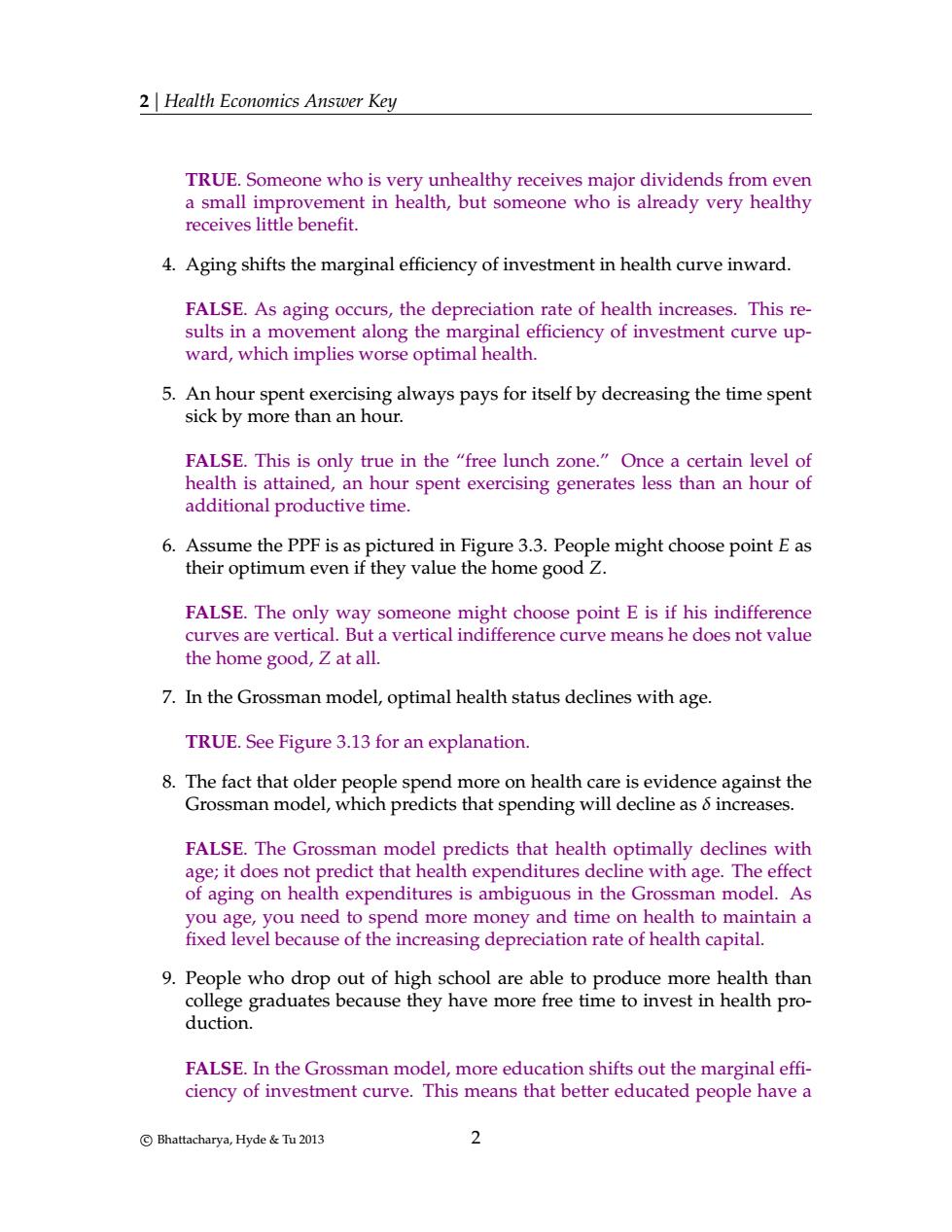正在加载图片...

2 Health Economics Answer Key TRUE.Someone who is very unhealthy receives major dividends from ever a small nt in health,but someone who is already very healthy 4.Aging shifts the marginal efficiency of investment in health curve inward. FALSE.As aging occurs,the depreciation rate of health increases.This re sults in a movement along the marginal efficiency of investment curve up- ward,which implies worse optimal health. 5.An hour spent exercising always pays for itself by decreasing the time spent sick by more than an hour. FALSE.This is only true in the "free lunch zone."Once a certain level of health is attained an hour spent exercising generates less than an hour of additional productive time 6.Assume the PPF is as pictured in Fi re3.3.Pe ple might choose point E as their optimum even if they value the home good FALSE.The only way someone might choose point E is if his indifference curves are vertical.But a vertical indifference curve means he does not value the home good,Z at all. 7.In the Grossman model,optimal health status declines with age. TRUE.See Figure 3.13 for an explanation. 8.The fact that older people spend more on health care is evidence against the Grossman model,which predicts that spending will decline as 8 increases. FALSE.The Grossman model predicts that health optimally declines with age:it doesno redict that expendit re with age.The effect you age,you need to spend more money and time on health to maintain a fixed level because of the increasing depreciation rate of health capital. 9.People who drop out of high school are able to produce more health than college graduates because they have more free time to invest in health pro- duction. FALSE.In the Grossman model,more education shifts out the marginal effi- ciency of investment curve.This means that better educated people have a Bhattacharya,Hyde &Tu2013 22 | Health Economics Answer Key TRUE. Someone who is very unhealthy receives major dividends from even a small improvement in health, but someone who is already very healthy receives little benefit. 4. Aging shifts the marginal efficiency of investment in health curve inward. FALSE. As aging occurs, the depreciation rate of health increases. This results in a movement along the marginal efficiency of investment curve upward, which implies worse optimal health. 5. An hour spent exercising always pays for itself by decreasing the time spent sick by more than an hour. FALSE. This is only true in the “free lunch zone.” Once a certain level of health is attained, an hour spent exercising generates less than an hour of additional productive time. 6. Assume the PPF is as pictured in Figure 3.3. People might choose point E as their optimum even if they value the home good Z. FALSE. The only way someone might choose point E is if his indifference curves are vertical. But a vertical indifference curve means he does not value the home good, Z at all. 7. In the Grossman model, optimal health status declines with age. TRUE. See Figure 3.13 for an explanation. 8. The fact that older people spend more on health care is evidence against the Grossman model, which predicts that spending will decline as increases. FALSE. The Grossman model predicts that health optimally declines with age; it does not predict that health expenditures decline with age. The effect of aging on health expenditures is ambiguous in the Grossman model. As you age, you need to spend more money and time on health to maintain a fixed level because of the increasing depreciation rate of health capital. 9. People who drop out of high school are able to produce more health than college graduates because they have more free time to invest in health production. FALSE. In the Grossman model, more education shifts out the marginal effi- ciency of investment curve. This means that better educated people have a c Bhattacharya, Hyde & Tu 2013 2